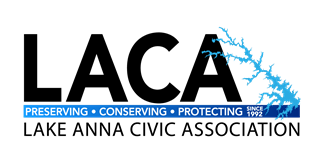By Mike Gelber - February 2021
Lake Anna was created from farmland and is fed by streams that run through existing working farms. There are also many homes surrounding the lake with septic systems and large expanses of lawn. These factor into the large amounts of nutrients coming into the lake causing excessive algae growth. Some algae are harmless, but others create toxins that are harmful to people and animals.
Several LACA committees have been researching ways to naturally diminish the amount of algae in the lake by reducing the nutrients. Traditional wetlands are one way to achieve this but are extremely expensive due to the need to purchase land and a monumental amount of work to create and maintain. The large amount of funding needed for wetlands was not achievable.
While researching ways to reduce the nutrient levels, we discovered Floating Treatment Wetlands (FTW). The concentrated nature of these floating wetlands (a 250 sq. ft. FTW is equivalent to a full acre of traditional wetlands), makes them extremely cost and space effective. One 250 sq. ft. floating island has the potential to prevent the growth of up to 11,000 lbs. of wet algae biomass.

Plants used on these floating islands are native to Virginia, are non-aggressive and non-invasive. They provide a sustainable pollutant-removal system and wildlife habitat. FTWs can tolerate water-level fluctuations if they are tethered so they are not damaged or lost. These islands can also enhance the visual appeal and interest in the lake. The variety of plants like Lobelia Cardinalis, Iris Versicolor, Broadleaf Arrowhead, Water Millet, Swamp Sunflower and others can provide year-round interest and beauty. Plants attract insects and birds, and the island surface can provide small animal habitat. Island shade and roots provide cover for fish and invertebrates. Island material and root systems provide valuable surface area for beneficial microbes to grow and pull pollutants from the water through hydroponics.
We have created several test floating islands which are being monitored through the winter. We used different construction materials and plant choices. For flotation of these islands, we collected hundreds of empty plastic water and soda bottles and put them into the frame. This helps decrease plastic waste in the environment.
Plants continue to do well, and we are expecting good growth in the spring. They continue to ride the waves well. The little fish seem to use them for shelter, and we have seen some good size bass and sun fish hanging around the test islands. So when you see a 25 x 5 foot island of flowers and grasses floating in the lake you’ll know what it is.
